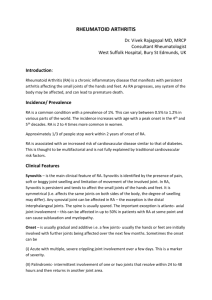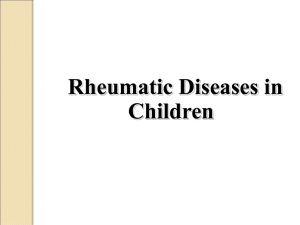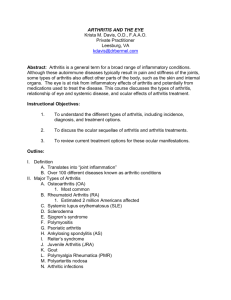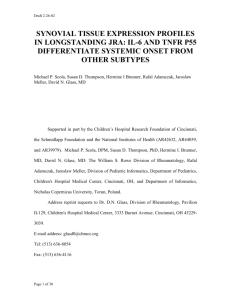Brief Overview of the Spectrum of Still`s Disease :: Martinez
advertisement
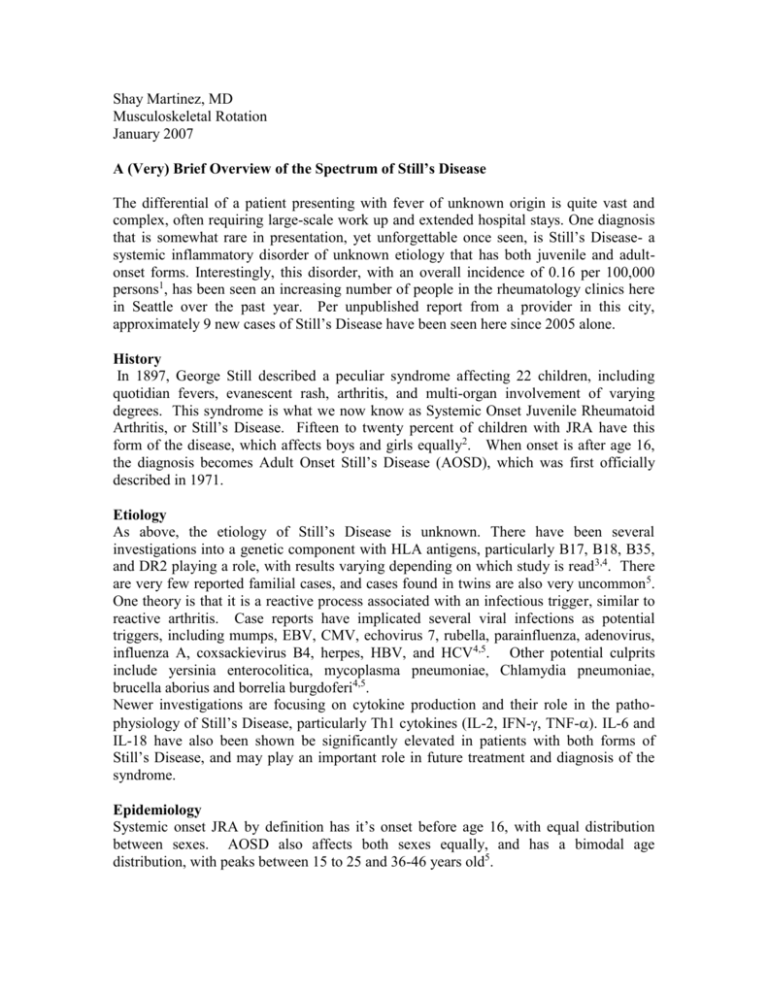
Shay Martinez, MD Musculoskeletal Rotation January 2007 A (Very) Brief Overview of the Spectrum of Still’s Disease The differential of a patient presenting with fever of unknown origin is quite vast and complex, often requiring large-scale work up and extended hospital stays. One diagnosis that is somewhat rare in presentation, yet unforgettable once seen, is Still’s Disease- a systemic inflammatory disorder of unknown etiology that has both juvenile and adultonset forms. Interestingly, this disorder, with an overall incidence of 0.16 per 100,000 persons1, has been seen an increasing number of people in the rheumatology clinics here in Seattle over the past year. Per unpublished report from a provider in this city, approximately 9 new cases of Still’s Disease have been seen here since 2005 alone. History In 1897, George Still described a peculiar syndrome affecting 22 children, including quotidian fevers, evanescent rash, arthritis, and multi-organ involvement of varying degrees. This syndrome is what we now know as Systemic Onset Juvenile Rheumatoid Arthritis, or Still’s Disease. Fifteen to twenty percent of children with JRA have this form of the disease, which affects boys and girls equally2. When onset is after age 16, the diagnosis becomes Adult Onset Still’s Disease (AOSD), which was first officially described in 1971. Etiology As above, the etiology of Still’s Disease is unknown. There have been several investigations into a genetic component with HLA antigens, particularly B17, B18, B35, and DR2 playing a role, with results varying depending on which study is read3,4. There are very few reported familial cases, and cases found in twins are also very uncommon 5. One theory is that it is a reactive process associated with an infectious trigger, similar to reactive arthritis. Case reports have implicated several viral infections as potential triggers, including mumps, EBV, CMV, echovirus 7, rubella, parainfluenza, adenovirus, influenza A, coxsackievirus B4, herpes, HBV, and HCV4,5. Other potential culprits include yersinia enterocolitica, mycoplasma pneumoniae, Chlamydia pneumoniae, brucella aborius and borrelia burgdoferi4,5. Newer investigations are focusing on cytokine production and their role in the pathophysiology of Still’s Disease, particularly Th1 cytokines (IL-2, IFN-, TNF-). IL-6 and IL-18 have also been shown be significantly elevated in patients with both forms of Still’s Disease, and may play an important role in future treatment and diagnosis of the syndrome. Epidemiology Systemic onset JRA by definition has it’s onset before age 16, with equal distribution between sexes. AOSD also affects both sexes equally, and has a bimodal age distribution, with peaks between 15 to 25 and 36-46 years old5. Diagnosis There are no specific tests used for diagnosing Still’s Disease- it remains both a clinical diagnosis and a one of exclusion. To this end, there are major and minor criteria, as well as exclusion criteria, that must be met to make the diagnosis of AOSD. Please see table one below: www.uptodate.com Systemic onset juvenile RA shares the same criteria, however can be somewhat harder to diagnose, as the arthritis that is necessary to make the diagnosis is often not apparent in the early stages with young patients. In both forms, patients are often initially thought to have infection given the presentation with high spiking fevers, rashes, leukocytosis, and anemia. Leukemia is also often on the first differential list. The lack of antibiotic response is often the first clue that infection is not the cause of the illness. Clinical Manifestations The classic triad of Still’s Disease is, as stated before, quotidian fevers, rash, and arthralgias/arthritis. The fevers are high spiking, usually greater than 39C, with startling temperature swings of up to 4 C within 4 hours4,5. The classic rash is an evanescent, salmon pink, maculopapular, and sometimes pruritic eruption that can be found diffusely, but is most often seen on the trunk and proximal limbs. It is most apparent with the fever, and often fades with defervescence. It has also been known to exhibit the Keobner phenomenon, being precipitated by rubbing the skin or trauma2,5. www.uptodate.com Distribution of joint involvement is usually symmetric and polyarticular, and like the rash, arthralgias may worsen with fever spikes. Musculoskeletal manifestations most often involve the knees, wrists, ankles, elbows, PIPs, and shoulders. Involvement of the wrist is most characteristic for adult disease, and bony changes in wrist joints usually present about 6 months after onset of the disease, with ankylosis developing within 1.5-3 years4. For children, the hips are often involved, and are commonly the first joints to show signs of arthritis. In addition, up to 50 percent of children with the disease occurring in the first decade of life will develop micrognathia and cervical spine fusion within months to years of onset. Other manifestations are diverse and variable in severity. Nonsuppurative pharyngitis is a very common and benign associated finding. Liver enzymes and hepatomegaly are frequently found, in up to 50-75% of cases of AOSD4. Tender lymphadenopathy with splenomegaly is found in up to half of patients, often leading to an initial diagnosis of lymphoma2. Lymph node biopsy, however shows only paracortical immunoblastic hyperplasia with polyclonal B-cell lineage, which is distinctly different from the histological patterns seen in RA, SLE, Sjögrens, and lymphoma5. Renal disease is uncommon, however can be quite severe when it does appear. More serious complications are also possible. Cardiopulmonary involvement, such as pericarditis and transient pulmonary infiltrates are more commonly seen in adult onset, whereas hemophagocytic syndrome and a significant anemia can be seen in both adult and juvenile forms. Laboratory Findings As stated above, there are no specific tests available to diagnose Still’s Disease. There are, however, certain laboratory abnormalities commonly seen that, along with appropriate clinical signs and symptoms, can be highly suggestive of the diagnosis. The majority of the laboratory abnormalities are indicators of the systemic inflammation and cytokine cascade that are hallmarks of the disease process itself5. An elevated ESR is almost universal in patients with Still’s Disease. CRP may also be elevated, however RF and ANA very rarely positive. Leukocytosis, largely secondary to striking neutrophilia, is typical, with WBC ranging from 15,000 –30,0002,3. Normocytic anemia and a marked reactive thrombocytosis are also quite common. In fact, the presence of thrombocytosis is so universal that a trend in the opposite direction is worrisome, and should immediately initiate a workup for hemophagocytic syndrome, a potentially life-threatening systemic inflammatory response that occurs more frequently in Still’s Disease than other rheumatologic conditions, as well as malignancy and DIC6. Liver function tests, including LDH, AST, ALT, bilirubin and GGT can be elevated. These can range from minimally abnormal to the rare case of fulminant hepatic failure (which have all been associated with concomitant ASA or NSAID use)2,5. Serum ferritin and glycosylated fraction of ferritin have more recently been used as more specific markers of the disease process. Ferritin acts as an acute phase reactant, as hepatocytes respond to inflammatory cytokine stimulation by producing it. Up to 70% of patients with AOSD have markedly elevated serum ferritin levels, which fluctuate along with disease activity5. Ferritin is also used in monitoring the juvenile form of Still’s. The degree of hyperferritinemia seen in Still’s Disease, which is commonly above 3000 mg/mL, is not found in other rheumatologic disorders, consequently this level of hyperferritinemia, along with other consistent signs and symptoms can be considered a fairly reliable indicator of disease presence2,4,5,6. It’s usefulness is limited, however, by it’s presence in other, non-rheumatologic illness, such as hemochromatosis, certain infections and malignancies, and hemophagocytic syndrome. Glycosylated ferritin is being hailed as a more specific marker of disease. In healthy people, between 50-80% of ferritin is glycosylated4. In inflammatory disorders the glycosylated portion is decreased by 20-50%, with Still’s Disease notable for a markedly lower glycosylated fraction than most other inflammatory conditions (3.7% vs. 30% in one study)5. This marker, however, is not useful in disease monitoring, as it can remain markedly low even in remission. The combination of a ferritin elevated five-fold and a glycosylated fraction less than 20% has been shown to have a sensitivity of 43% for AOSD, and a specificity of 93%5. Many of the laboratory abnormalities seen in Still’s Disease are also commonly seen in hemophagocytic syndrome, which as stated before is a potentially fatal inflammatory reaction. The differentiating factor is the presence of arthritis, which is not seen in the former. AOSD vs. Systemic Onset JRA There is, at preset, no consensus on whether AOSD and systemic onset JRA are in fact the same entity affecting two age groups or entirely different processes. They share the same clinical features as well as the same cytokine profile involved in pathogenesis. The main difference remains the prognosis and disease course. Children affected by this disorder are more likely to develop a chronic, potentially destructive arthritis (30-50% vs. ~30% in adults) and their disease tends to be more refractory to treatment2,5,6. Disease Course The clinical course of AOSD is broken down into three categories, with approximately one-third of patients falling into each. The most fortunate patients experience a selflimited process with complete resolution, usually within one year. The second group experiences an intermittent course of recurrent flares. The flares tend to become less severe and shorter in duration with time, and there is typically complete remission in between them. The last category involves a chronic course, with persistently active disease sometimes leading to a destructive arthritis requiring arthroplasty5. There are predictors for worse prognosis and poor outcome in AOSD, including early development of polyarthritis with proximal or root joint (shoulders, hips) involvement, and the requirement for systemic steroid therapy for more than 2 years5. The course of systemic onset JRA is similar but tends to be more variable. The initial course of spiking fevers, rash, and arthritis/arthralgias lasts at least 6 months. Forty to fifty percent of children will eventually have complete resolution of the arthritis component of the disease, however a good portion will experience recurrence years after. In fact, there are some adults newly diagnosed with AOSD who may very well have juvenile Still’s that resolved at an early age. As with AOSD, there is a portion of children with Still’s who will continue to have active disease. Unfortunately, the prognostic factors that predict a worse outcome for AOSD are more common in children with the disease. As a result, children who grow into adults living with the chronic form of this disease have, for example, higher incidences of multiple joint replacements, leg length discrepancies, restricted jaw opening, and severe disability as determined by HAQ scores of 1.5 to 3.02. Secondary amyloidosis, while possible in both forms, is also higher in adults with juvenile onset. Treatment A general outline for the treatment of Still’s Disease is outline below. Though this is using data from the treatment of AOSD, the same basic structure can be extrapolated to the juvenile form as well. The important caveat to that is that it is often more difficult to effectively treat children, who tend to have more refractory disease. (Taken from reference 4) Treatment decisions depend on disease severity and acuity. The first choice for mild disease without significant systemic involvement continues to be NSAIDS and aspirin. Only 7-15% of patients are effectively controlled with NSAID monotherapy, however, and the use of glucocorticoids is almost universal4. These have their own side effect profile to deal with, especially in children who require long-term therapy (growth retardation, AVN, etc). As in rheumatoid arthritis, methotrexate is also used in those patients with chronic disease not responsive to steroids alone, however is less effective in children. For patients with more severe systemic involvement, disease that does not respond to the aforementioned treatments, and for children who are unable to be maintained on steroids for long periods of time, biologic agents are the mainstays of treatment, with anti-TNF and anti-IL1 agents leading the pack. Given the cytokine profile of the disease, with the marked elevation of IL-6 seen in both forms, ongoing studies are investigating the use of anti-IL-6 agents for treatment of systemic onset JRA. The drug being studied is called MRA, or tocilizumab, and has been shown in phase II trials to be significantly effective in reducing both clinical manifestations of the disease and in lowering inflammatory markers, without an extensive side effect profile7. Further studies are underway. References 1. Magudar-Joly G, Billaud E, Barrier JH, Pennec YL, Masson C, Renou P, et al. Epidemiology of adult Still’s disease: estimate of the incidence by a retrospective study in west France. Ann Rheum Dis 1995; 54:587-90. 2. Lehman, Thomas JA. Clinical manifestations and diagnosis of systemic onset juvenile rheumatoid arthritis. www.uptodate.com 3. Pouchat J, Sampalis JS, Carette S, Decary F, Salusinsky-Sternbach M, et al. Adult Still’s disease: manifestations, disease course, and outcome in 62 patients. Medicine (Baltimore) 1991; 70: 118-36. 4. Efthimiou P, Paik PK, and Bielory L. Diagnosis and management of adult onset Still’s disease. Ann Rheum Dis 2006; 65: 564-572. 5. Mandi Lisa A, and Esdaile John M. Adult Still’s Disease. www.uptodate.com 6. de Benedetti F, and Martini A. Targeting tieh Interleukin-6 Receptor: A New Treatment for Systemic Juvenile Idiopathic Athritis? Arthritis Rheum 2005; 52:687-693. 7. Woo P, Wilkinson N, Prieur AM, Southwood T, Leone V, Livermore P, et al. Open label phase II trial of single, ascending doses of MA in Caucasian children with severe systemic juvenile idiopathic arthritis: proof of principle of the efficacy of IL-6 receptor blockade in this type of arthritis and demonstration of prolonged clinical improvement. Arthritis Res Ther 2005; 7:R1281-R1288

